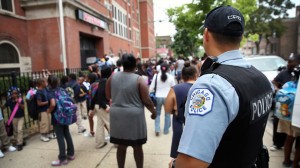 The US Department of Justice has pledged $44mn in grants to provide 356 school resource officers to 141 cities and counties nationwide in what it calls an effort to make schools safer following events like the Newtown, Connecticut, shooting in December.
The US Department of Justice has pledged $44mn in grants to provide 356 school resource officers to 141 cities and counties nationwide in what it calls an effort to make schools safer following events like the Newtown, Connecticut, shooting in December.
Grants intended to fund more police officers in schools will go to law enforcement agencies across the country, the Justice Department (DOJ) said Friday as it unveiled the entire list of recipients.
In Modesto, Calif., for example, the city school district will receive $1mln to fund eight new school resource officers.
Though spending details for the program are not yet available, in Modesto the City Council will have to approve the program, which requires grantees to match award totals two-to-one.
“Not only do they deter crime, but they provide opportunities for positive relations between students and law enforcement,” Karen Servas, a Modesto City School District grant writer who worked with the city police department to appeal for funding, told McClatchy.
Yet many critics say more armed police officers in schools is no guarantee for a safer environment, and will likely contribute to worsen the “school-to-prison pipeline” that groups like the American Civil Liberties Union (ACLU) say disproportionately targets youth of color and youth with disabilities.
The “school-to-prison pipeline” operates directly and indirectly, the ACLU writes in its research on punitive school discipline.
“Directly, schools send their students into the Pipeline through zero tolerance policies, and involving the police in minor discipline incidents. All too often school rules are enforced through metal detectors, pat-downs and frisks, arrests, and referrals to the juvenile justice system. And schools pressured to raise graduation and testing numbers can sometimes artificially achieve this by pushing out low-performing students into GED programs and the juvenile justice system.
“Indirectly, schools push students towards the criminal justice system by excluding them from the learning environment and isolating them from their peer groups through suspension, expulsion, ineffective retention policies, transfers, and high-stakes testing requirements.”
Marc Schindler, director of the Justice Policy Institute which seeks to reduce mass incarceration, believes the policy is misguided.
“There is no indication that the presence of (resource officers) makes schools safer,” Schindler said to McClatchy. “In fact, there’s research supporting that there’s likely unwanted consequences.”
The institute published a 2012 report entitled ‘The Case Against Police in Schools,’ which shows schools with officers make more arrests for minor offenses, among other issues.
“In terms of safe schools, research favors a supporting and nurturing environment based around counselors, social workers and teachers, which makes kids feel that they’re in a safe place,” Schindler said. “Because of rare but high-profile tragedies like Newtown, many are concerned about school safety. I have kids in school and I want them to be safe. … Unfortunately, things that sound good are not always the best response.”
The grants are part of Obama administration efforts to secure schools in the wake of shootings such as the December 2012 massacre at Sandy Hook Elementary School in Newtown, where 26 people, mostly small children, were shot and killed by a gunman who took his own life upon arrival of police at the scene.